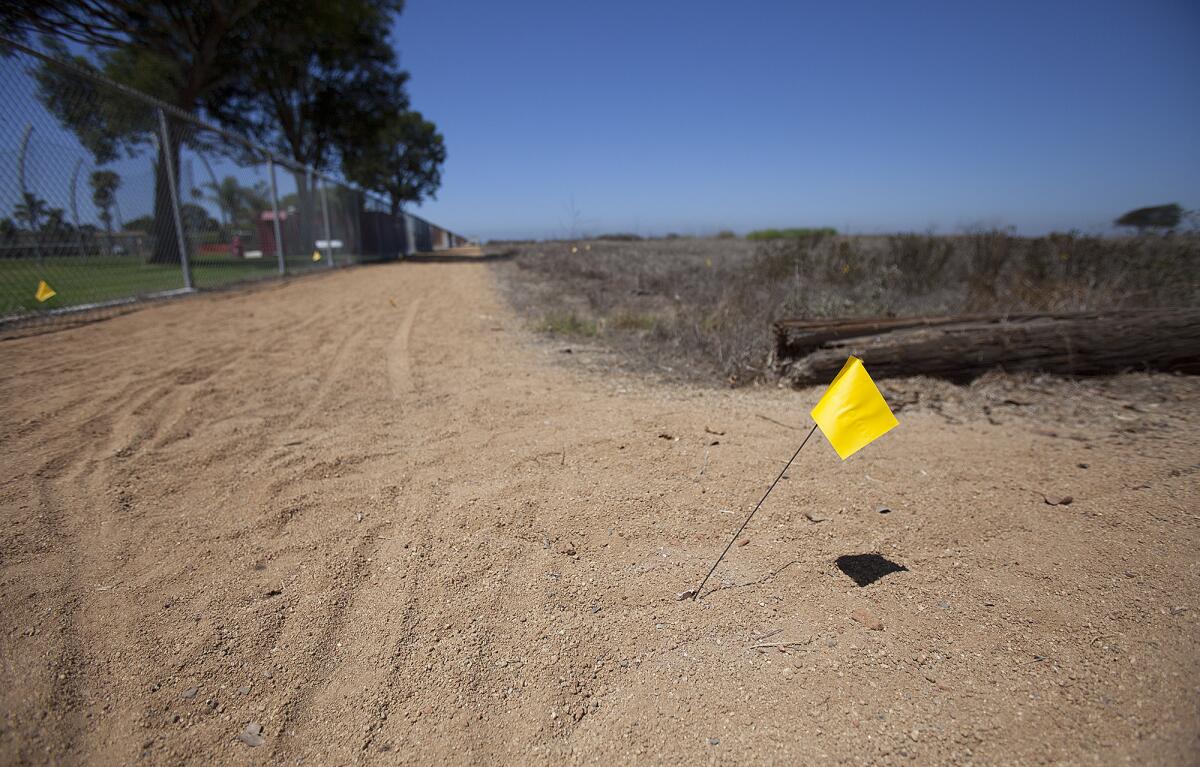Federal agency takes interest in Fairview trail

- Share via
The mysterious appearance of an unpermitted trail in Fairview Park has drawn federal attention.
Earlier this week, the U.S. Fish and Wildlife Service contacted Costa Mesa officials about the potential loss of federally protected vernal pools within the 208-acre park, according to an email Public Services Director Ernesto Munoz sent to the City Council and city officials.
The FWS has “requested the city work with them in the identification, delineation and restoration/mitigation of any of the federally protected vernal pools at Fairview Park that may have been compromised by park users,” Munoz wrote.
The Daily Pilot acquired the email Thursday.
Munoz’s notice, sent Wednesday afternoon, comes after a Pilot investigation published last week that reported environmental concerns surrounding the nearly 400-foot trail and its potential encroachment upon a small but sensitive habitat officially known as Vernal Pool 6. The trail, possibly constructed more than a month ago, runs east-west and is adjacent to Parsons Field.
No one has taken responsibility for creating the trail, which is made from decomposed granite. City officials have said the work took place without a permit.
Fairview Park has about seven vernal pools, temporary wetlands that host several types of species, among them the endangered San Diego fairy shrimp.
Munoz wrote that the city “will be working with our consultants, in concert with the U.S. Fish and Wildlife Service, to arrive at acceptable measures to mitigate and restore the federally protected pools.”
He also wrote that the city is going to buy cable railings, which will go around the vernal pools to prevent more “degradation and to assure they are adequately protected.”
FWS officials were not available for comment, though a spokeswoman confirmed that the agency contacted Costa Mesa after receiving a call from a concerned resident.
“They’re not upset about anything that’s going on,” Munoz said in an interview Friday about the federal agency’s involvement. “They essentially want to be part of the process, and we want them to be part of the process, about what the biologist is doing and how we proposed to mitigate any damage that may have occurred out there.”
The city is expected to prepare a report on the pools, which FWS will review.
“Hopefully, this report will give us the findings and the direction that we need,” Munoz said.
If mitigation is required because the vernal pools were disturbed, he added, possible steps may include restoring the existing pools or recreating the habitats elsewhere in the park.
The Fairview Park Citizens Advisory Committee will determine the course of action once the biologists’ recommendations are received, Munoz said.
Representatives from local groups that frequent the area — Costa Mesa United, Pop Warner football and the Harbor Soaring Society — have denied making the decomposed granite trail and improving another one near it using the same material.
The second trail, which runs north-south, is about 120 feet long and may have appeared in the years since the construction of Jim Scott Stadium in 2008.
The city paid a team of biologists to visit Fairview Park on Monday and map the park’s vernal pools, including Vernal Pool 6. The team included Ingri Quon, an associate biologist from LSA Associates’ Irvine office.
Quon said markers now reflect a 2006 mapping survey of the vernal pools and any minor modifications that could be ascertained considering the dry conditions during the team’s visit.
“It was the best data currently available, given the conditions,” she said Thursday.
As of Wednesday afternoon, a few of the markers — small, yellow flags — for Vernal Pool 6 were staked into the decomposed granite near where the east-west trail converges with the north-south trail.
Munoz said most of the park’s vernal pools haven’t been disturbed, but he couldn’t officially say if Vernal Pool 6 was affected by the trails.
“I will defer to the biologist to make that determination,” he said.
He added, however, that the likelihood that the pool was affected is high.
The trails have been constantly used and constantly weeded by the public and the city, Munoz said, with the last weeding as recent as May.
He has said the city considers the trails “user-defined,” meaning they appeared organically over time from park users. Some historic aerial photos of the area from decades ago also show trails of some kind there, Munoz said.
Some environmentalists have disagreed with the city’s user-defined distinction, however, pointing to the professional nature of the east-west trail’s construction and its sudden appearance.
*
Reactions
Councilwoman Sandy Genis, who serves as a council liaison to the Fairview Park Citizens Advisory Committee, said in her discussions with city staff members about the trail, they have been “apologists for what happened.”
“I really do hope that somebody takes responsibility. ... It’s a profound disappointment to me,” she said.
“It’s unfortunate that our city hasn’t done a better job and we need the federal government to step in. The thing about the federal government is they may be requesting, but it’s sort of like, ‘Talk softly and carry a bit stick.’”
Brian Burnett of Friends of Fairview Nature Park, which opposes development in the park, said in an email: “Critical habitat and endangered species are important to protect, as well as the peace and quiet the park provides. I hope that area is restored.
“Fairview is one of the last places left [where] kids can go exploring and experience nature firsthand in our city. Exploring fast-food parking lots on Harbor Boulevard just isn’t the same.”
Richard Mehren, chairman of the park’s advisory committee, said he visited the site this week and saw that some of the flags had already been stepped on or torn out. He tried to fix them.
Mehren alluded to the possibility of creating a buffer zone around the outline of the pools.
“That should’ve been done a long time ago, frankly,” he said.
